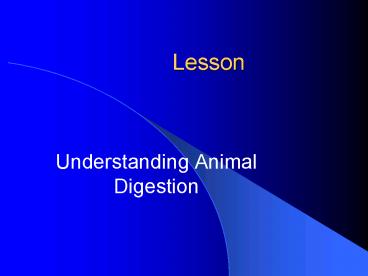Understanding Animal Digestion - PowerPoint PPT Presentation
1 / 26
Title:
Understanding Animal Digestion
Description:
Understanding Animal Digestion ... types of digestive systems is critical in selecting the proper feeds for livestock ... are combinations of amino acids. – PowerPoint PPT presentation
Number of Views:218
Avg rating:3.0/5.0
Title: Understanding Animal Digestion
1
Lesson
- Understanding Animal Digestion
2
Bell What is this?
3
What are the various types of digestive systems
found in animals?
- Knowledge of the different types of digestive
systems is critical in selecting the proper feeds
for livestock. - Understanding the chemical and physical changes
that occur during the digestion process leads to
more efficient livestock feeding.
4
Digestive Systems
- Digestion is the process of breaking down feed
into simple substances that can be absorbed by
the body. - Absorption is taking the digested parts of the
feed into the bloodstream.
5
Digestive Systems
- The digestive system consists of the parts of the
body involved in chewing and digesting feed. - This system also moves the digested feed through
the animals body and absorbs the products of
digestion.
6
Digestive Systems
- Different species of animals are better able to
digest certain types of feeds better than others.
- This difference occurs due to the various types
of digestive systems found in animals.
7
Digestive Systems
- There are four basic types of digestive systems
- Monogastric (simple)
- Avian
- Ruminants (polygastric)
- Pseudo-ruminants.
8
Monogastric
- A monogastric digestive system has a simple
stomach. - The stomach is a muscular organ that stores
ingested feed and moves it into the small
intestine. - The stomach secretes acid.
- The acid results in a low pH of 1.5 to 2.5. The
low pH destroys most bacteria and begins to break
down the feed materials.
9
Monogastric
- Animals with this type of digestive system are
better adapted to the use of concentrated feeds,
such as grains, than the use of large quantities
of roughages. - Examples of monogastric animals are dogs, cats,
swine and humans.
10
Pancreas
-Esophagus
Liver
Lg Intestine
-Rectum
---Anus
Stomach
Small Intestine
11
- YouTube - digestive system animation monogastric
12
Pseudo-ruminant
- D. A pseudo-ruminant is an animal that eats large
amounts of roughage but does not have a stomach
with several compartments. - The digestive system does some of the same
functions as those of ruminants. - They are able to utilize large amounts of
roughages because of the greatly enlarged cecum
and large intestine.
13
Pseudo-ruminant
- These animals often eat forages as well as grains
and other concentrated feeds. - Examples of pseudo-ruminants are horses, rabbits,
guinea pigs, and hamsters.
14
Colon
-Rectum
Esophagus
Stomach
15
- YouTube - 3D Horse Digestion Guide
16
What are the major parts of the digestive system
and their functions?
- The digestive system is made up of a number of
parts known as organs. - The system beings at the mouth, where food enters
the body, and continues until anus, where
undigested material exits the body. - The digestive systems of most livestock are very
similar in terms of the organs they contain.
17
Mouth and Esophagus
- The chewing action of the mouth and teeth breaks,
cuts, and tears up the feed. - This increases the surface area of the feed
particles which aids in the chewing and
swallowing process. - Saliva stimulates the taste of the feed but also
contains the enzymes, salivary amylase and
salivary maltase.
18
Mouth and Esophagus
- Enzymes are substance called organic catalysts
that speed up the digestive process. - Salivary amylase changes starch to maltose or
malt sugar. - Salivary maltase changes maltose to glucose.
19
Small Intestine
- 1. Pancreatic juice secreted by the pancreas,
contains the enzymes trypsin, pancreatic amylase,
pancreatic lipase, and maltase. - Trypsin breaks down proteins not broken down by
pepsin. - Some of the proteoses and peptones are broken
down by trypsin to peptides.
20
Pancreatic Juice
- Proteoses, peptones, and peptides are
combinations of amino acids. - Proteoses are the most complex compounds and
peptides are the simplest. - Lipase works on fats in the feed.
- It changes them into fatty acids and glycerol.
21
Pancreatic Juice
- Pancreatic amylase changes starch in the feed to
maltose. - Sugar and maltose are then broken down even
further by maltase. - They are then changed into a simple sugar called
glucose.
22
Bile
- Bile is a yellowish-green, alkaline, bitter
liquid produced in the liver. - Bile is stored in the gall bladder in all animals
except horses. - Bile aids in the digestion of fats and fatty
acids. - It also aids in the action of the enzyme lipase.
23
Intestinal Juice
- Glands in the walls of the small intestine
produce intestinal juice. - This fluid contains peptidase, sucrase, maltase,
and lactase, all enzymes used in digestion. - Proteoses and peptones are broken down by
peptidase into amino acids. - Starches and sugars are broken down by sucrase,
maltase, and lactase into the simple sugars,
glucose, fructose, and galactose.
24
Large Intestine
- The main function of this organ is to absorb
water. - Material not digested and absorbed in the small
intestine passes into the large intestine.
25
Large Intestine
- Feed materials that are not digested or absorbed
are called feces. - This material is moved through the large
intestine by muscles in the intestinal walls. - The undigested part of feed is passed out the
body through the anus, the opening at the end of
the large intestine.
26
Review / Summary
- What are the various types of digestive systems
found in animals? - What are the major parts of the digestive system
and their functions?































